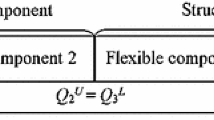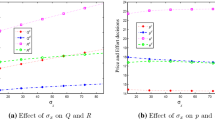Abstract
We analyse a decentralized supply chain consisting of a supplier and a retailer. The terms of trade between the two agents are specified by a quantity flexibility (QF) contract. We first identify the Pareto QF contracts for the supply chain where each agent adopts a satisficing objective, that is, to maximize the probability of achieving his/her predetermined target profit. It is shown that to coordinate such a supply chain, QF contracts have to degenerate into wholesale price (WP) contracts. This provides an additional justification for the popularity of WP contracts besides their simplicities and lower administration costs. Next, we consider the supply chain where each agent adopts multiple objectives, namely the satisficing objective and the objective of expected profit maximization (EPM). It is shown that there always exist QF contracts that coordinate the supply chain under the objective of EPM and are simultaneously Pareto optimal for the satisficing objective.




Similar content being viewed by others
References
Barr S (2003). Target setting: Art or science?... Or both? Mezhermnt 4: 1–5.
Brown AO and Tang CS (2006). The impact of alternative performance measures on single-period inventory policy. J Ind Mngt Optim 2: 297–318.
Cachon G (2003). Supply chain coordination with contracts. In: de Kok AG and Graves SC (eds). Supply Chain Management: Design, Coordination and Operation. Elsevier: Amsterdam, The Netherlands.
Cachon G (2004). The allocation of inventory risk in a supply chain: Push, pull, and advance-purchase discount contracts. Mngt Sci 50: 222–238.
Gan X, Sethi S and Yan H (2004). Coordination of a supply chain with risk-averse agents. Prod Opns Mngt 13: 135–149.
Kabak IW and Schiff AI (1978). Inventory models and management objectives. Sloan Mngt Rev 19: 53–59.
Lanzillotti RF (1958). Pricing objectives in large companies. Am Econ Rev 48: 921–940.
Lariviere MA (1999). Supply chain contracting and coordination with stochastic demand. In: Tayur S, Ganeshan R and Magazine M (eds). Quantitative Models for Supply Chain Management. Kluwer Academic Publishers: Norwell, MA.
Lau H (1980). The newsboy problem under alternative optimization objectives. J Opl Res Soc 31: 393–403.
Lau A and Lau H (1988). Maximizing the probability of achieving a target profit level in a two-product newsboy problem. Decis Sci 19: 392–408.
Lovell CAK and Pastor JT (1997). Target setting: An application to a bank branch network. Eur J Opl Res 98: 290–299.
Markowitz H (1959). Portfolio Selection: Efficient Diversification of Investment. Cowles Foundation Monograph 16. Yale University Press: New Haven, CT.
McTaggart J and Gillis S (1998). Setting targets to maximize shareholder value. Strat Leadership 26: 18–21.
Parlar M and Weng ZK (2003). Balancing desirable but conflicting objectives in the newsvendor problem. IIE Trans 35: 131–142.
Sankarasubramanian E and Kumaraswamy S (1983). Optimal order quantity for per-determined level of profit. Mngt Sci 29: 512–514.
Shi C and Chen B (2006). Pareto optimal contracts for a supply chain with satisficing objectives. J Opl Res Soc, doi:10.1057/palgrave.jors.2602186.
Simon HA (1959). Theories of decision-making in economics and behavioral science. Am Econ Rev 49: 253–283.
Spengler J (1950). Vertical integration and antitrust policy. J Polit Econ 58: 347–352.
Tayur S Ganeshan R and Magazine M (eds). (1999). Quantitative Models for Supply Chain Management. Kluwer: Boston, MA.
Tsay AA (1999). The quantity flexibility contract and supplier–customer incentives. Mngt Sci 45: 1339–1358.
Author information
Authors and Affiliations
Corresponding author
Rights and permissions
About this article
Cite this article
Shi, C., Chen, B. Pareto quantity flexibility contracts for a supply chain under multiple objectives. J Oper Res Soc 59, 685–692 (2008). https://doi.org/10.1057/palgrave.jors.2602378
Received:
Accepted:
Published:
Issue Date:
DOI: https://doi.org/10.1057/palgrave.jors.2602378




